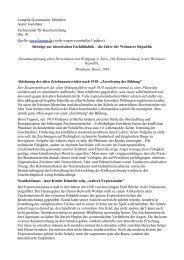Research in Visual Arts Education - The National Society for ...
Research in Visual Arts Education - The National Society for ...
Research in Visual Arts Education - The National Society for ...
Create successful ePaper yourself
Turn your PDF publications into a flip-book with our unique Google optimized e-Paper software.
MULTICULTURALISM AND ARTS-BASED RESEARCH<br />
practice. Dissertations connected to the school practices are the sites where<br />
research categories emphasiz<strong>in</strong>g visual arts or education meet. Both action<br />
research and methods related to it have been used <strong>in</strong> F<strong>in</strong>land, with researchers<br />
also work<strong>in</strong>g as teachers. Action research has been connected to critical<br />
pedagogy, and “artistic action research” has been discussed (see Räsänen,<br />
2005). More ethnographically orientated methods have been used <strong>in</strong> the studies<br />
of Kankkunen (2004) and Kantonen (2005). Both Räsänen’s (1997) and<br />
Viitanen’s (1998) dissertations about art <strong>in</strong>terpretation have strong connections<br />
to school practices. So does Heidi Karv<strong>in</strong>en’s (2004) study about arts<br />
and <strong>in</strong>terdiscipl<strong>in</strong>arity at elementary level that is also an example of education<br />
through art. In her licentiate thesis, Anna-Christ<strong>in</strong>a Forsman (1997)<br />
searches practical tools <strong>for</strong> classroom teachers to promote visual th<strong>in</strong>k<strong>in</strong>g<br />
through <strong>in</strong>structional discussions. <strong>Education</strong>al assessment is approached <strong>in</strong><br />
two licentiate theses. Inari Grönholm (1999) describes one portfolio process<br />
and Martti Raevaara (1999) <strong>in</strong>terviews students and teachers participat<strong>in</strong>g<br />
<strong>in</strong> group critiques <strong>in</strong> f<strong>in</strong>e art classes at the UIAH.<br />
Contemporary art theories and issues of philosophy of art education have<br />
been vividly discussed among F<strong>in</strong>nish art scholars dur<strong>in</strong>g the period of this<br />
report (see Varto, 1996; 2003). However, philosophy is the theoretical background<br />
only <strong>in</strong> M<strong>in</strong>na Kallio’s thesis (2005) on the significance of the image<br />
<strong>in</strong> educational context. In her licentiate thesis, Raija Miett<strong>in</strong>en (1998) discusses<br />
aesthetic education and the mean<strong>in</strong>g of art <strong>in</strong> personal development.<br />
Sirkka Lait<strong>in</strong>en (2003) puts the issue <strong>in</strong>to school practice by study<strong>in</strong>g the<br />
possibilities of visual art education <strong>in</strong> back<strong>in</strong>g up the youth’s aesthetical and<br />
ethical th<strong>in</strong>k<strong>in</strong>g. <strong>The</strong>ories of learn<strong>in</strong>g and mean<strong>in</strong>g-mak<strong>in</strong>g <strong>in</strong> F<strong>in</strong>nish research<br />
<strong>in</strong> art education very much touch upon the issues of postmodern art theory.<br />
Empower<strong>in</strong>g environmental art is the framework of Kaija Hannula’s (2002)<br />
licentiate thesis. Seija Karpp<strong>in</strong>en (2005) makes conceptual analysis of basic<br />
crafts education by ask<strong>in</strong>g what art makes of crafts. Helena Sederholm (1998)<br />
studies the ways to approach experiential and social modes of contemporary<br />
art. Her work has connections to <strong>in</strong>tegration and multimodal teach<strong>in</strong>g and<br />
learn<strong>in</strong>g <strong>in</strong> arts education.<br />
Look<strong>in</strong>g towards the future<br />
See<strong>in</strong>g F<strong>in</strong>nish studies <strong>in</strong> art education (both at master’s and doctoral levels)<br />
<strong>in</strong> relation to Lars L<strong>in</strong>dström’s knowledge base of visual arts education, it<br />
is easy to fill most of its categories. Some concepts used by Liora Bresler<br />
(2007) <strong>in</strong> her handbook of research <strong>in</strong> arts education serve as useful subtitles<br />
when look<strong>in</strong>g at the F<strong>in</strong>nish research <strong>in</strong> progress (see also Eisner & Day,<br />
NORDIC VISUAL ARTS EDUCATION IN TRANSITION 105



